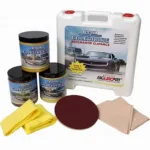Knowing how to properly prime and paint car repair spots can save you a lot of money and frustration. It’s a process that requires patience, attention to detail, and the right materials. This comprehensive guide will walk you through the steps, from prepping the area to applying the final coat of paint, ensuring a professional-looking finish.
Understanding the Importance of Proper Preparation
Before you even think about cracking open a can of primer, the most crucial step is preparing the repair area. This involves:
- Cleaning: Thoroughly wash the area with soap and water to remove dirt, grease, and any other contaminants.
- Sanding: Use varying grits of sandpaper, starting with a coarser grit and progressively moving to a finer grit, to create a smooth and even surface for the primer to adhere to.
- Masking: Protect surrounding areas that you don’t want to paint by carefully applying masking tape and paper.
Choosing the Right Primer for the Job
Selecting the correct primer is vital for a long-lasting and flawless finish. Consider these factors:
- Type of Repair: For minor scratches and imperfections, a self-etching primer is usually sufficient. Deeper repairs, like dents or rust spots, might require a more specialized primer, such as a filler primer.
- Material: Different primers are designed for specific materials. Ensure the primer you choose is compatible with your car’s body material, whether it’s steel, aluminum, or fiberglass.
- Color: Primer color can impact the final paint color. For lighter paint colors, a white or light gray primer is recommended, while a darker gray or black primer is suitable for darker paint colors.
Applying Primer Like a Pro
Once you’ve prepped the area and chosen the appropriate primer, it’s time to apply:
- Shake Well: Vigorously shake the primer can for the recommended time to ensure the contents are properly mixed.
- Thin Coats: Apply thin, even coats of primer, holding the can about 6-8 inches away from the surface. Avoid applying thick coats, as this can lead to drips and uneven drying.
- Drying Time: Allow each coat of primer to dry completely before applying the next. Refer to the manufacturer’s instructions for recommended drying times.
- Sanding Between Coats: After each coat of primer has dried, lightly sand the surface with fine-grit sandpaper to create a smooth base for the next coat.
Painting Over Primer for a Seamless Finish
After the final coat of primer has dried and been sanded smooth, it’s time for the color coat:
- Choose the Right Paint: Use automotive paint that matches your car’s existing paint color. You can purchase pre-mixed paint or have it custom-matched at an auto parts store.
- Apply Thin Coats: Similar to the primer, apply thin, even coats of paint, maintaining a consistent distance from the surface. Overlapping each pass slightly will ensure full coverage.
- Drying Time: Allow each coat of paint to dry thoroughly before applying the next.
- Clear Coat (Optional): For added protection and a glossy finish, apply a clear coat after the final coat of paint has dried.
Common Mistakes to Avoid
- Skipping Preparation: Inadequate surface preparation is the most common mistake that leads to poor paint adhesion and an unprofessional finish.
- Applying Thick Coats: Thick coats of primer or paint take longer to dry and are more prone to runs, drips, and orange peel texture.
- Ignoring Drying Times: Not allowing sufficient drying time between coats can trap solvents, leading to bubbling, cracking, and other paint defects.
- Rushing the Process: Priming and painting car repair spots requires patience and attention to detail. Rushing the process can compromise the quality of the repair.
Final Thoughts
By following these steps and avoiding common mistakes, you can achieve professional-looking results when priming and painting car repair spots. Remember, patience is key, and using the right materials and techniques will make all the difference in achieving a flawless finish.
Expert Insight: “Many people underestimate the importance of proper surface preparation. Spending extra time on this crucial step will save you headaches down the line and ensure a long-lasting and professional-looking repair.” – John Smith, Automotive Paint Specialist
FAQs
Q: Can I use regular spray paint on my car?
A: No, it’s not recommended. Regular spray paint lacks the durability and UV protection of automotive paint and can fade, chip, or peel quickly.
Q: How long does it take for primer to dry?
A: Drying times vary depending on the type of primer and environmental conditions, but generally, it takes 30 minutes to an hour for primer to dry to the touch.
Q: How many coats of paint do I need?
A: Typically, 2-3 thin coats of paint are sufficient for good coverage.
For more information on car repair and maintenance, check out our other informative articles on CarRepairOnline.
Need help with your car repair? Contact us on WhatsApp: +1(641)206-8880, Email: [email protected]. Our dedicated team is available 24/7 to assist you.



